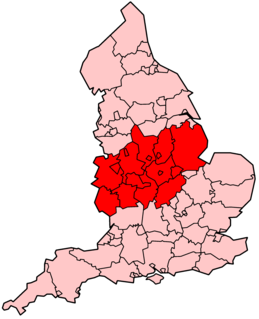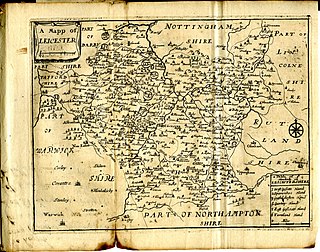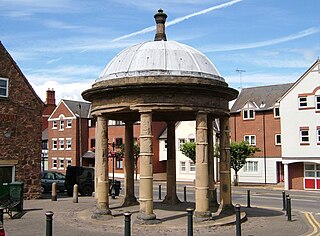Related Research Articles

The East Midlands is one of nine official regions of England at the first level of ITL for statistical purposes. It consists of Derbyshire, Leicestershire, Lincolnshire, Northamptonshire, Nottinghamshire and Rutland. The region has an area of 15,627 km2 (6,034 sq mi), with a population over 4.5 million in 2011. The most populous settlements in the region are Derby, Leicester, Lincoln, Mansfield, Northampton and Nottingham. Other notable settlements include Boston, Chesterfield, Corby, Grantham, Hinckley, Kettering, Loughborough, Newark-on-Trent, Skegness, Wellingborough, and Worksop.

Leicestershire is a landlocked county in the English Midlands, being within the East Midlands. The county borders Nottinghamshire to the north, Lincolnshire to the north-east, Rutland to the east, Northamptonshire to the south-east, Warwickshire to the south-west, Staffordshire to the west, and Derbyshire to the north-west. The border with most of Warwickshire is Watling Street, the modern A5 road.

Breedon on the Hill is a village and civil parish about 5 miles (8 km) north of Ashby-de-la-Zouch in North West Leicestershire, England. The parish adjoins the Derbyshire county boundary and the village is only about 2 miles (3 km) south of the Derbyshire town of Melbourne. The 2001 Census recorded a parish population of 958 people in 404 households. The parish includes the hamlets of Tonge 1 mile (1.6 km) east of the village and Wilson 1.3 miles (2 km) north of the village on the county boundary. The population at the 2011 census was 1,029 in 450 households.

The Midlands is a part of England and a cultural area that broadly corresponds to the Kingdom of Mercia of the Early Middle Ages. The Midlands region is bordered by Northern England and Southern England. The Midlands were important in the Industrial Revolution of the 18th and 19th centuries. Two of the nine official regions of England are the West Midlands and East Midlands. Birmingham, in the West Midlands, is the second-largest city and metropolitan area in the United Kingdom.

Loughborough is a market town in the Charnwood borough of Leicestershire, England, the seat of Charnwood Borough Council and Loughborough University. Its 59,933 inhabitants in the 2011 census were estimated at 67,956 in 2019, as the county's second largest settlement. It is close to the Nottinghamshire border and short distances from Leicester, Nottingham, East Midlands Airport and Derby. It has the world's largest bell foundry, John Taylor Bellfounders, which made bells for the Carillon War Memorial, a landmark in the Queens Park in the town, of Great Paul for St Paul's Cathedral, and for York Minster.

Melton Mowbray is a town in Leicestershire, England, 19 miles (31 km) north-east of Leicester, and 20 miles (32 km) south-east of Nottingham. It lies on the River Eye, known below Melton as the Wreake. The town population of 27,158 in the 2011 census was estimated at 27,670 in 2019. Its culinary speciality is the Melton Mowbray pork pie. It is also the location of one of six licensed makers of Stilton cheese. It is sometimes promoted as Britain's "Rural Capital of Food".

The Jewry Wall is a substantial ruined wall of 2nd-century Roman masonry, with two large archways, in Leicester, England. It stands alongside St Nicholas' Circle and St Nicholas' Church. It formed the west wall of a public building in Ratae Corieltauvorum, alongside public baths, the foundations of which were excavated in the 1930s and are also open to view. The wall gives its name to the adjacent Jewry Wall Museum.

Shepshed, often known until 1888 as Sheepshed, is a town in Leicestershire, England with a population of 13,505 at the 2011 census. It is part of the borough of Charnwood local authority, where Shepshed is the second biggest settlement after the town of Loughborough.

This article is intended to give an overview of the history of Leicestershire.

Anstey is a large village in Leicestershire, England, located north west of Leicester in the borough of Charnwood. Its population was 6,528 at the 2011 census. This figure is expected to increase due to the building of a new housing development off Groby Road. The village is separated from Leicester by the Rothley Brook, Castle Hill Park and the A46, and it borders the villages of Glenfield, Groby, Newtown Linford, Cropston and Thurcaston as well as the suburb of Beaumont Leys and Anstey Heights. To the north-west lies Bradgate Park.

Mountsorrel is a village in Leicestershire on the River Soar, just south of Loughborough with a population in 2001 of 6,662 inhabitants, increasing to 8,223 at the 2011 census.

Martinsthorpe is a civil parish in the county of Rutland in the East Midlands of England.

Bringhurst is a small village and civil parish in the Harborough district of south-east Leicestershire, bordering Northamptonshire and Rutland. Nearby places are Cottingham in Northants, Great Easton and Drayton in Leicestershire, and Caldecott in Rutland. The population is included in the civil parish of Great Easton.

Braunstone is a civil parish and is the largest parish within the district of Blaby in Leicestershire, England, now known as the Town of Braunstone or more commonly, Braunstone Town. In 2007 the population was around 15,000. There are around 7,500 households including Thorpe Astley. At the 2011 census the population of the civil parish had increased to 16,850.

Stockerston is a village and civil parish in the Harborough district of Leicestershire, England, located on the border with Rutland, by the Eye Brook. According to the 2001 census the parish had a population of 35. The population remained less than 100 at the 2011 census and is included in the civil parish of Horninghold.
Cricket may not have reached the English counties of Leicestershire and Rutland until the 18th century. A notice in the Leicester Journal dated 17 August 1776 is the earliest known mention of cricket in the area. A few years later, a Leicestershire & Rutland Cricket Club was taking part in important matches. Note that in some contemporary reports the club is called simply Leicester but the personnel involved are the same whichever title is used.
The River Eye is a river in north-eastern Leicestershire that becomes the Wreake.
References
- ↑ Hoskins, W. G., "The deserted villages of Leicestershire" in The Transactions of the Leicestershire Archaeological Society; Vol. 22, Leicester, 1945
- ↑ Hoskins, W. G., Essays in Leicestershire History, Liverpool, 1950
- ↑ Hoskins, W. G., "Seven deserted villages in Leicestershire" in The Transactions of the Leicestershire Archaeological Society; Vol. 32, Leicester, 1956
- ↑ Hoskins, W. G., ed. A History of the County of Leicester; Vol. III, London, 1955
- ↑ Hurst, J. G. & Beresford, M. W., eds. "Provisional list of deserted medieval villages in Leicestershire" in The Transactions of the Leicestershire Archaeological Society; Vol. 39, Leicester, 1964
- ↑ Cox, B., The Place-names of Leicestershire Part 1 The Borough of Leicester, Nottingham, 1998
- ↑ Cox, B., A Dictionary of Leicestershire and Rutland Place-names, Nottingham, 2005
- ↑ Cox, B., The Place-names of Leicestershire Part 5 Guthlaxton Hundred, Nottingham, 2011
- ↑ Cox, B., The Place-names of Leicestershire Part 4 Gartree Hundred, Nottingham, 2009
- ↑ Cox, B., The Place-names of Leicestershire Part 3 East Goscote Hundred, Nottingham, 2004
- ↑ Cox, B., A Dictionary of Leicestershire and Rutland Place-names, Nottingham, 2005
- ↑ Cox, B., The Place-names of Leicestershire Part 3 East Goscote Hundred, Nottingham, 2004
- ↑ Cox, B., A Dictionary of Leicestershire and Rutland Place-names, Nottingham, 2005
- ↑ Rivet, A. L. F. & Smith, C., The Place Names of Roman Britain, London, 1979
- ↑ Cox, B., The Place-names of Leicestershire Part 2 Framland Hundred, Nottingham, 2002
- ↑ Cox, B., A Dictionary of Leicestershire and Rutland Place-names, Nottingham, 2005
- ↑ Beresford, M. W., The Lost Villages of England, Stroud, 1987
- ↑ Hoskins, W. G., "Seven deserted villages in Leicestershire" in The Transactions of the Leicestershire Archaeological Society; Vol. 32, Leicester, 1956
- ↑ Morgan, P., Domesday Book 22 Leicestershire, Chichester, 1979
- ↑ Cox, B., The Place-names of Leicestershire Part 5 Guthlaxton Hundred, Nottingham, 2011
- ↑ Cox, B., The Place-names of Leicestershire Part 2 Framland Hundred, Nottingham, 2002
- ↑ Cox, B., The Place-names of Leicestershire Part 1 The Borough of Leicester, Nottingham, 1998
- ↑ Lapidge, M., The Blackwell Encyclopaedia of Anglo-Saxon England, Oxford, 1999
- ↑ Billson, C. J., Medieval Leicester, Leicester, 1920
- ↑ Cox, B., The Place-names of Leicestershire Part 1 The Borough of Leicester, Nottingham, 1998
- ↑ Lapidge, M., The Blackwell Encyclopaedia of Anglo-Saxon England, Oxford, 1999
- ↑ Cox, B., The Place-names of Leicestershire Part 1 The Borough of Leicester, Nottingham, 1998
- ↑ Chinnery, G. A., Records of the Borough of Leicester; Vols. V-VII, Leicester, 1965-1974
- ↑ The National Archives, London, 1851 Census of England, Leicestershire Loughborough District 3n, Images 38-41 accessed via Ancestry.co.uk
- ↑ The National Archives, London, 1861 Census of England, Leicestershire Loughborough District 6 Image 28, accessed via Ancestry.co.uk
- ↑ Cox B, The Place-names of Leicestershire Part 1 The Borough of Leicester, Nottingham, 1998
- ↑ Ordnance Survey Street Atlas of Leicestershire and Rutland, London, 2000,
- ↑ Ordnance Survey Explorer Map 233 Leicester and Hinckley, Southampton, 2000
- ↑ Cox, B., A Dictionary of Leicestershire and Rutland Place-names, Nottingham, 2005
- ↑ Hoskins, W. G., "Seven deserted villages in Leicestershire" in The Transactions of the Leicestershire Archaeological Society; Vol. 32, Leicester, 1956